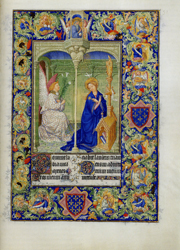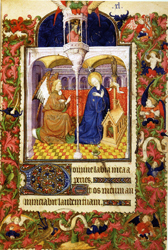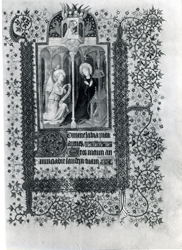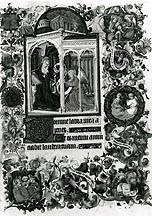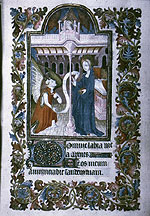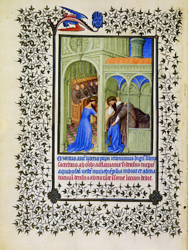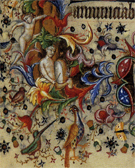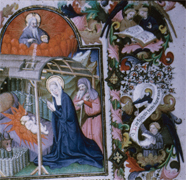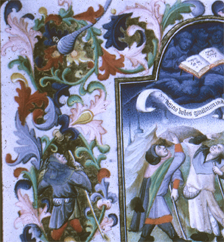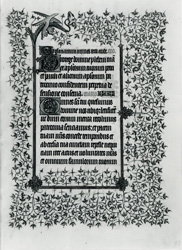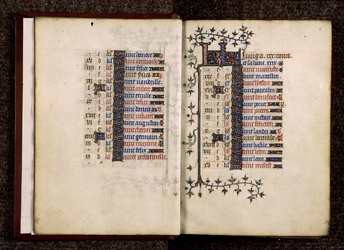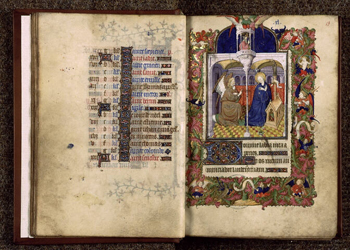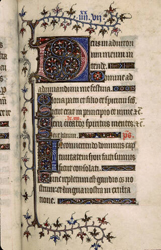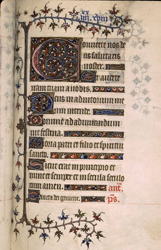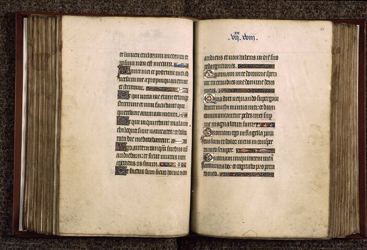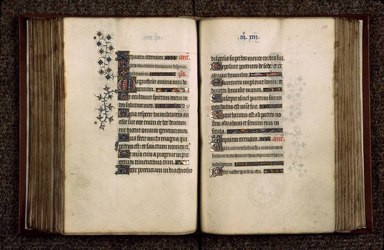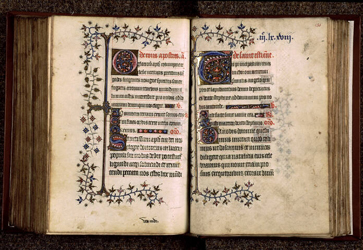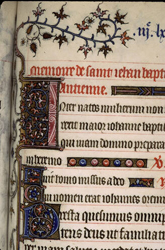Marginal Matters Home | Catalog of Decorators | Catalog of Manuscripts | Table of Collaboration
Paris, Bibliothèque Sainte Geneviève, MS 2713
Book of Hours
In his entry for the Sainte Geneviève Hours in the Limbourg Brothers catalog (no. 119, pp. 406-407), Gregory Clark attributes the single miniature in the manuscript to the Mazarine Master. He compares the miniature to the image of the same subject in the Saint Maur Hours (Paris, B.N. Nouv. acq. lat. 3107, fol. 45). Clark goes as far as to say that the Sainte-Geneviève image "is derived from the same subject in the Saint-Maur Hours." Both of these images of the Annunciation are clearly related to the Annunciation in the Belles Heures. Understanding the dependence of the Sainte-Geneviève miniature on the Saint Maur Hours, Clark dates the Sainte-Geneviève manuscript to about 1410, the generally accepted dating of the Saint Maur Hours.
Philadelphia, Collins. 45-65-5
There is good reason to believe that the Sainte-Geneviève manuscript was produced several years earlier. Overlooked in Clark's examination of the manuscript are the parallels to a Book of Hours in Bodleian Library (Douce 144). This Oxford manuscript is an important landmark in the development of Parisian manuscript decoration. A note on folio 27, apparently written by the scribe, states : "factum et completum est anno M'. CCCC'. VII' quo ceciderunt pontes par." That the bridges of Paris were swept away by floods a t the end of January, 1408, indicates a date for this note between then and the end of March of 1408. This manuscript has been claimed to represent the first securely dated Parisian manuscript to make extensive use of acanthus decoration, and has been used, therefore, as evidence for dating other manuscripts which have extensive acanthus decoration. Comparison of the openings of Matins of the Hours of the Virgin in the Belles Heures, Douce 144, and the Sainte-Geneviève manuscripts reveals significant correspondences. While the connections between the miniatures of the Annunciation in the Belles Heures and the Sainte-Geneviève manuscripts are unmistakeable, the Annunciation of the Oxford book also demonstrates knowledge of Limbourg compositions used in the New York manuscript. This is evident in a comparison of the architecture of the Annunciation in the Oxford Hours to that found in the miniature on fol. 184v that is part of the St Jerome cycle.
The style of the Sainte Geneviève manuscript's Annunciation comes closer to that of the Bedford style of Douce 144. This is evident in the facial types especially of God the Father and the angel. A motif used by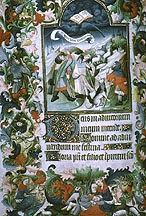 the Bedford artist a number of times in Douce 144 is to transform the background with monochromatic angels. [monochromatic angels are used by Master of the Brussels initials in Add 29433, see Meiss, 1967, fig. 769 Also see Coronation Master image in fr. 242, f. 1 Boucicaut master uses it in BL add 16997 [meiss, Boucicaut, fig 289 291 see Mazarine 469 [meiss, Bouc, fig 263 See Chateauroux Breviary [Meiss Boucicaut, figs 110 and 111] See also Tres Belles Heures, Meiss, 67, fig 8,13,27 and 28] This is found in Douce 144 in background above the building in the Annunciation and in the angels included in the miniature of the Annunciation to the Shepherds. This motif is found in the background encircling the God the Father. Perhaps the most striking similarity between Douce 144 and the Sainte-Geneviève manuscript is border decoration. These miniature borders with their dense acanthus decoration and alternation between prophets and music playing angels present intriguing parallels to the border of the Annunciation in the Belles Heures. This is the only example of acanthus decoration in the New York manuscript. As the earliest dated manuscript to make extensive use of acanthus decoration Douce 144 along with the work of the Master of the Brussels Initials have been cited as parallels to the decoration of the Belles Heures Annunciation page. The inclusion of prophets and music playing angels in the Belles Heures, Douce 144, and the Sainte-Geneviève manuscript suggest a closer relationship between these manuscripts than to the work of the Master of the Brussels Initials. A distinctive aspect of the Belles Heures decoration is the setting of the acanthus decoration against a blue background enframed in gold. The gold background of the acanthus in the Sainte-Geneviève manuscript comes closest to the Belles Heures. note that the gold background of the border of sainte genevieve can be seen in strips along the side of f. 2v of Douce 144 and other pages.
the Bedford artist a number of times in Douce 144 is to transform the background with monochromatic angels. [monochromatic angels are used by Master of the Brussels initials in Add 29433, see Meiss, 1967, fig. 769 Also see Coronation Master image in fr. 242, f. 1 Boucicaut master uses it in BL add 16997 [meiss, Boucicaut, fig 289 291 see Mazarine 469 [meiss, Bouc, fig 263 See Chateauroux Breviary [Meiss Boucicaut, figs 110 and 111] See also Tres Belles Heures, Meiss, 67, fig 8,13,27 and 28] This is found in Douce 144 in background above the building in the Annunciation and in the angels included in the miniature of the Annunciation to the Shepherds. This motif is found in the background encircling the God the Father. Perhaps the most striking similarity between Douce 144 and the Sainte-Geneviève manuscript is border decoration. These miniature borders with their dense acanthus decoration and alternation between prophets and music playing angels present intriguing parallels to the border of the Annunciation in the Belles Heures. This is the only example of acanthus decoration in the New York manuscript. As the earliest dated manuscript to make extensive use of acanthus decoration Douce 144 along with the work of the Master of the Brussels Initials have been cited as parallels to the decoration of the Belles Heures Annunciation page. The inclusion of prophets and music playing angels in the Belles Heures, Douce 144, and the Sainte-Geneviève manuscript suggest a closer relationship between these manuscripts than to the work of the Master of the Brussels Initials. A distinctive aspect of the Belles Heures decoration is the setting of the acanthus decoration against a blue background enframed in gold. The gold background of the acanthus in the Sainte-Geneviève manuscript comes closest to the Belles Heures. note that the gold background of the border of sainte genevieve can be seen in strips along the side of f. 2v of Douce 144 and other pages.
Compare the music playing angels to those included in Cotton Domitian AXVII: 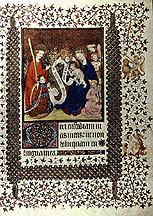
New York, The Cloisters, Belles Heures, f. 30 detail |
|
Paris, Bibliothèque Sainte-Geneviève, f. 13 detail |
Oxford, Bodleian Library, Douce 144, f. 63, detail |
Oxford, Bodleian Library, Douce 144, f. 1, detail |
Oxford, Bodleian Library, Douce 144, f. 68v, detail |
The connections  between these manuscripts extends to their secondary decoration. The work of the decorator I have identified as the A Master of the Belles Heures can be found not only in the Belles Heures but also Sainte-Geneviève 2713, Douce 144, the Saint Maur Hours, and even one of the principal manuscripts associated with the Master of the Brussels Initials, London, British Library, Add. 29433. A detail of a single page from the Sainte Geneviève manuscript confirms this attribution. The tendrils in the penned rinceaux extending from the letter "m" are identifiable as those distinctive of the A Master's work. The pronounced cusping of the leaves and the sawtooth white highlighting of the initial are consistent with this decorator's work. Examination of samples of this artisan's work in these manuscripts confirms the attribution but also suggests a chronology in their production.
between these manuscripts extends to their secondary decoration. The work of the decorator I have identified as the A Master of the Belles Heures can be found not only in the Belles Heures but also Sainte-Geneviève 2713, Douce 144, the Saint Maur Hours, and even one of the principal manuscripts associated with the Master of the Brussels Initials, London, British Library, Add. 29433. A detail of a single page from the Sainte Geneviève manuscript confirms this attribution. The tendrils in the penned rinceaux extending from the letter "m" are identifiable as those distinctive of the A Master's work. The pronounced cusping of the leaves and the sawtooth white highlighting of the initial are consistent with this decorator's work. Examination of samples of this artisan's work in these manuscripts confirms the attribution but also suggests a chronology in their production.
As I have demonstrated elsewhere the decorative plan of the St. Maur Hours is closely related to that of the Belles Heures. This is most evident in the use of bar staffs around three sides of the page with quatrefoils marking the lower corners of the staffs. The page from the London manuscript also uses this layout of the staff, but uses painted rinceaux decoration instead of the penned line rinceaux with gold leaves found in both the decoration of the St. Maur Hours and the Belles Heures. In contrast to the heavy acanthus leaves and painted rinceaux found on miniature pages in Douce 144, the standard text pages are decorated with a bar staff on the outside of every page with penned rinceaux with gold leaves. The use of the penned rinceaux with gold leaves as opposed to the use of the more traditional painted rinceaux reflects a change in aesthetics in border decoration. While penned lines and gold leaves are lighter than the painted rinceaux, the penned decoration of Douce 144, the Belles Heures, and the St. Maur Hours creates decorative blocks that echo the text blocks of the respective pages. While penned decoration can be found in Sainte Geneviève MS 2713, it clearly supplements the predominance of the painted rinceaux decoration which is much sparser and does not create a decorative block. 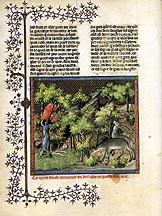 The decorative scheme of MS 2713 can be compared with the work of the A Master in the Paris copy of the Livre de la Chasse (fr. 616).
The decorative scheme of MS 2713 can be compared with the work of the A Master in the Paris copy of the Livre de la Chasse (fr. 616).
The closest parallels to the decoration of MS 2713 can be found in two manuscripts: one in the British Library and the other in the Getty collection. The London manuscript (Egerton 2709) is the only extant copy of the first account of the French conquest of the Canary Islands. The manuscript appears to date between the summer of 1404 and 1408. The text includes references to events through July of 1404. An entry in the inventory made after the death in 1408 of Valentine de Milan, the widow of Louis d'Orléans, to a "livre du Canerien couvert d'une peau de viel velue" indicates that copies of the text were present in ducal collections by 1408. It seems likely that Egerton 2709 dates between 1404 and 1408.
Except for the border decoration on folio 13 marking the incipit of Matins of the Hours of the Virgin, the secondary decoration of ms 2713 can be attributed to the A Master of the Belles Heures. The closest comparisons to the other works by the A Master can be found in Egerton 2709, Getty ms 72, and fr. 616.
The manuscript only has a single miniature. This is the Annunciation on folio 13. This miniature is clearly related to the same subject in the Belles Heures. The similarities are not limited to the miniatures but also include the acanthus borders with prophets and music playing angels. An additional comparison can be made with the same page in Oxford, Douce 144. The catalog entry for the Sainte Geneviève manuscript for the Limbourg Brothers exhibition attributes the Annunciation to the Mazarine Master and compares the miniature to the Annunciation in the St. Maur Hours. While the Mazarine Master did contribute to the Oxford manuscript, the Annunciation in the Sainte Geneviève Hours seems closer to the so-called Bedford style in Douce 144. This is especially evident in the facial types in the angel and the God the Father. The acanthus decoration are strikingly similar to that found in Douce 144.
| A Jacques Rapponde, la somme de LX fr. d'or, lesquelz du commandement de feu mons. le duc, cui Dieu perdoint! et par ordonnance de maistre Jehan Durant, conseiller de mondit Sr, ycellui Jaques bailla et délivra pour faire ystroires en la Bible en latin et en françoiz que ledit feu Monsr faisoit faire; laquelle mondit Sr. a donnée à Monsr de Berry: aux personnes qui s'ensivent, c'est assavoir: à Ymbert Stanier, enlumineur, XXIIII fr. le premier jour de mars mil cccc et III [this would be 1404 n.s]. Item, le IIIe jour dudid moin en suivant à Jacques Cone, paintre, XX fr. Item à Hainsselin de Haguenot, enlumineur, le XVIIe jour de mai mil cccc et quatre, XVI fr. Pour ce, par mandement de mondit Sr donné à Conflans-lez-Paris le XXIIe jour de mai, mil cccc et sept. [Meiss, Boucicaut Master, p. 141] |
See Meiss, Boucicaut, pp. 65-66 for a discussion of this document
Lauds of HBVM, f. 34v-35 As represented here, major texts begin on the recto of the leaf. The verso of the preceding leaf is left blank when the preceding text ends on the recto. This suggests that full page miniatures were intended to open major texts. It is interesting that the opening of Matins of the Hours of the Virgin, the most important opening in the manuscript has a half page miniature. There does not appear to be any rubbing from miniatures which suggests that the full page miniatures were never added. |
|
|
|
|
||
